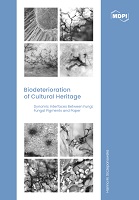Biodeterioration of Cultural Heritage
Dynamic Interfaces between Fungi, Fungal Pigments and Paper
| dc.contributor.author | Szczepanowska, Hanna | |
| dc.date.accessioned | 2023-07-03T10:21:48Z | |
| dc.date.available | 2023-07-03T10:21:48Z | |
| dc.date.issued | 2023 | |
| dc.identifier.uri | https://library.oapen.org/handle/20.500.12657/63723 | |
| dc.description.abstract | Fungi-induced stains on paper are one of the most challenging forms of biodeterioration to study and to prevent; this is because they involve living organisms, and the ways in which fungi respond to changes in the environment and modifications of paper are unpredictable. Yet, there is a great desire among those who encounter fungi on documents, manuscripts, or artwork to remove fungi and clean the paper. This experience in most cases is particularly challenging. What are the reasons behind this challenge? This ground-breaking book attempts to answer this question, among others, by exploring the complex interfacial forces between paper, fungi, and their pigmented secretions which result in bio-stains on paper. Black fungi, collectively referred to as Dematiaceous fungi, were used in this study as a subset of pigment-producing fungi species. The focus is on two, under-studied aspects of the fungi infestation of paper, an interface of fungal pigments and paper, and the impact of light on the production of fungi bio-stains. The results of analytical testing included in this book elucidate the synergistic interactions between the environment, biological clocks of the microorganisms, and secretion of fungal pigments to paper. The black fungal pigment formation is explored in-depth in two scenarios: one that is ‘natural’, when the bio-stains of original artworks have occurred over time by chance, and another, induced by Aspergillus niger, in bio-simulation on known papers in a controlled environment. The findings are intended to provide guidance for preservation strategies, mitigating the biodeterioration of paper, and designing conservation treatment when applicable. The surface of artworks and artifacts is of great aesthetic and artistic importance; conversely, it plays a significant role in governing fungal attachments. In this book, the paper surface is characterized in detail and in correlation with chemical and physical alterations caused by fungal pigmentation. A broad range of analytical instruments was used for surface characterization, such as surface metrology profilometers, a confocal laser scanning microscope, and environmental scanning electron microscope; chemical microanalysis was carried out using X-ray energy dispersive spectroscopy. The novel, three-dimensional characterization of pigmented fungal inclusions and their interaction with paper matrix was studied with micro-X-ray-computed micro-tomography on the synchrotron ESRF. The proposed book is the first to explore the complexity of fungal–paper interactions with the intention to assist professionals working with cultural materials, especially paper-based materials, to make informed decisions when dealing with the fungi infestation of paper. | en_US |
| dc.language | English | en_US |
| dc.subject.classification | thema EDItEUR::G Reference, Information and Interdisciplinary subjects::GP Research and information: general | en_US |
| dc.subject.classification | thema EDItEUR::P Mathematics and Science::PS Biology, life sciences | en_US |
| dc.subject.other | Dematiaceous fungi; fungal pigments; X-ray-CT microtomography; fungi-paper interfaces | en_US |
| dc.title | Biodeterioration of Cultural Heritage | en_US |
| dc.title.alternative | Dynamic Interfaces between Fungi, Fungal Pigments and Paper | en_US |
| dc.type | book | |
| oapen.identifier.doi | 10.3390/books978-3-0365-2093-3 | en_US |
| oapen.relation.isPublishedBy | 99f56ef3-04bd-4875-9e06-b59649a200cf | * |
| oapen.relation.isbn | 9783036520940 | en_US |
| oapen.pages | 186 | en_US |
| oapen.place.publication | Basel | en_US |

